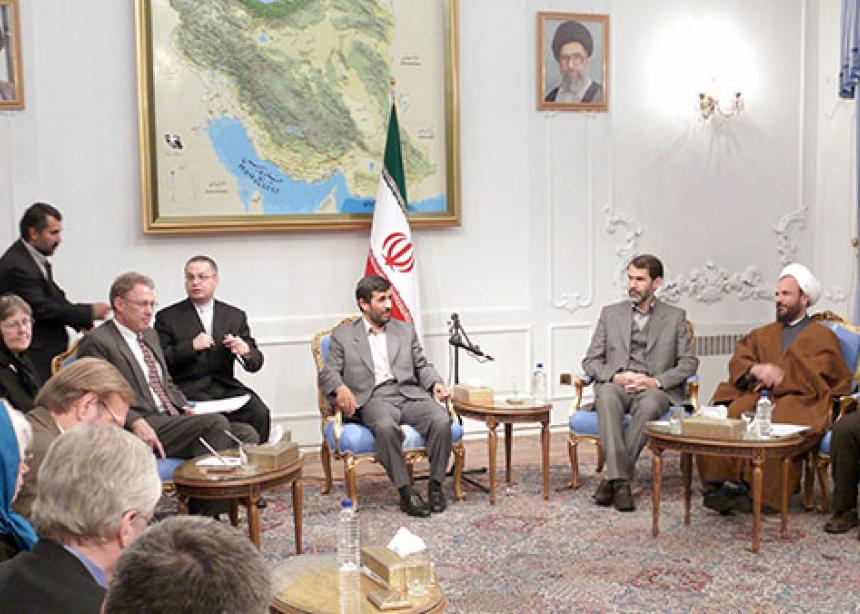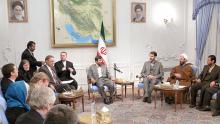After Iranians replace Mahmoud Ahmadinejad, a two-term president, in this month’s elections, much of the world will remember him as an enigmatic hardliner from a far-off place. They will remember a stern, blustery man whose nuclear dabbling and inflammatory rhetoric about Israel and America seemed to invoke George W. Bush’s inclusion of Iran among the “Axis of Evil.”
But Ed Martin’s recollections of one of the world’s most notorious heads of state will be somewhat more nuanced and much more personal. He will recall talking politics and religion with Ahmadinejad until 10:30 on a February night six years ago in Tehran. Martin, who was the Mennonite Central Committee (MCC) point person on Iran from 1989-2007, was part of an MCC-led delegation invited to the president’s complex, the first time a sitting Iranian president had met with Americans on Iranian soil since the 1979 revolution.
It wasn’t the first or last time Martin would be part of face-to-face meetings with Ahmadinejad. The first meeting had taken place the previous September in New York City, an unexpected culmination of relationships that Martin and MCC had developed with Iranians over 16 years.
A 1990 earthquake was the occasion for MCC’s initial efforts to connect with Iran, although another key factor was MCC’s desire to transcend the growing enmity between Iran and the West. At the time, Islam was replacing communism as the West’s enemy of choice and Tehran was replacing Moscow as the epicentre of evil.
Although MCC never placed long-term personnel in Iran, Martin travelled there at least once annually for many years, cultivating relationships. His contacts with Iranian officials led to a series of student exchanges in which American Mennonites studied Islam in Iran and Iranian students studied religion and peacebuilding in Toronto and at Eastern Mennonite University (EMU) in Virginia.
The first Iranian student to attend EMU was Ali Akbar Rezaei, who later became a senior official in Iran’s foreign ministry and a force behind the MCC meetings with the president. According to Martin, Rezaei wanted the president to meet people who presented a face of America that was different than that put forward by the U.S. government or Iranian media.
In all, MCC held four meetings with Ahmadinejad between September 2006 and September 2008, all at the president’s initiative.
Robb Davis was head of MCC when the first invitation to meet came. He led the delegation of 45 religious leaders who attended the meeting at Ahmadinejad’s New York hotel. In his opening comments, Davis welcomed the president, indicating that the sensitive questions to follow didn’t diminish the welcome. Then he asked for forgiveness.
In 1953—a date seared in Iranian memory—the U.S. and Britain orchestrated a military coup that ousted the democratically elected president of Iran. The western allies gained access to Iranian oil under the new leader, Shah Pahlavi. The shah became a repressive authoritarian, with continued western backing and American-trained secret police, until a popular revolt ended his reign in 1979.
Those 26 years of U.S.-backed repression dominate the Iranian narrative about the U.S., which is why Davis requested forgiveness. He says the apology was for benefitting from U.S. government actions that “oppressed” people in Iran, and for “not fundamentally questioning” government actions.
Davis says the president’s response was muted.
At the close of the meeting, Davis suggested that a delegation of American religious leaders visit Iran. Ahmadinejad responded, via translation, by saying that they should come in February when the nights are long and they could talk late into the evening.
While Davis characterizes the meeting as formal, Martin says Davis and Ahmadinejad developed significant rapport, something that was lost when Davis resigned from MCC the next month.
The later meetings were larger and more public. As this happened, the dialogue increasingly became a “platform for other people’s purposes,” both in Iran and the U.S., according to Arli Klassen, head of MCC at the time of the final meeting.
The next year, when Iranian officials invited MCC to another meeting with Ahmadinejad, MCC declined.
Klassen says that at each meeting MCC was able to clearly state that its motivation for dialogue arose from a commitment to Jesus. Ahmadinejad was also consistently questioned regarding religious freedom in Iran, the country’s nuclear program, his call for the destruction of Israel and his questioning of the Holocaust.
Bert Lobe, who moderated the third meeting on MCC’s behalf, said via e-mail from Asia that Ahmadinejad “felt both brittle and preoccupied” during the meeting, seldom making eye contact. But up close, when Lobe pinned a dove on Ahmadinejad’s label, the president “softened.”
For Klassen, the bottom line is simple. “It’s always better to talk with those with whom we disagree, than to not talk.”



Add new comment
Canadian Mennonite invites comments and encourages constructive discussion about our content. Actual full names (first and last) are required. Comments are moderated and may be edited. They will not appear online until approved and will be posted during business hours. Some comments may be reproduced in print.